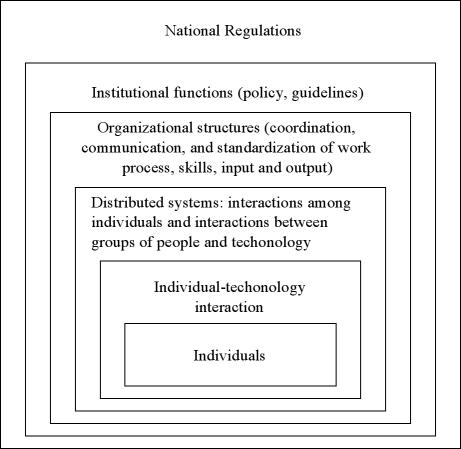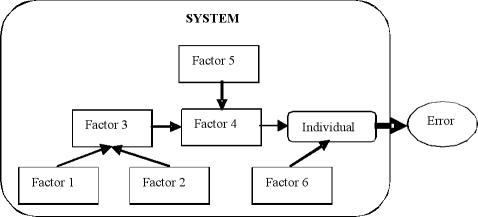Abstract
Is the solution for medical errors medical or cognitive? In this AMIA2001 panel on medical error, we argued that medical error is primarily an issue for cognitive science and engineering, not for medicine, although the knowledge of the practice of medicine is essential for the research and prevention of medical errors. The three panelists presented studies that demonstrate that cognitive research is the foundation for theories of medical errors and interventions of error reductions.
Why Cognitive, Not Medical?
In our opinion, medical error is an issue for cognitive science and engineering, not medicine, although the knowledge of the practice of medicine is essential for the research and prevention of medical error. This is because cognitive factors are fundamental in medical errors, as can be seen from the very definition of medical errors, the view of the healthcare system hierarchy (Figure 1▶), and the view of action chains (Figure 2▶).
Figure 1 .
The system hierarchy of medical errors.
Figure 2 .
The chain of events leading to an error.
Medical errors are human errors in healthcare. By definition,6,9 human errors are errors in human actions. Human actions are primarily cognitive activities. It is not surprising to see that human errors occur primarily due to inadequate information processing in cognitive tasks.2,9,10
Cognitive factors are critical at various levels of the healthcare system hierarchy of medical errors (Figure 1▶). At the lowest core level, it is individuals who trigger errors. Cognitive factors of individuals play the most critical role here.9 At the next level, errors can occur due to interactions between an individual and technology. This is an issue of human-computer interaction where cognitive properties of interactions between human and technology affect and sometimes determine human behavior.4,12 At the next level, errors can be attributed to the social dynamics of interactions between groups of people who interact with complex technology in a distributed cognitive system. This is the issue of distributed cognition and computer-supported cooperative work.1,5,11 At the next few levels up, errors can be attributed to factors of organizational structures (e.g., coordination, communications, standardization of work process), institutional functions (e.g., policies and guidelines), and national regulations. At these higher levels, cognitive factors also play some roles. Although the properties at the six levels can be to some extent studied independently, a cognitive foundation for the system is essential for a complete and in-depth understanding of medical errors.
From the view of action chains, the critical roles of cognitive factors in medical errors are also clear. Figure 2▶ shows the chain of events and factors that lead to an error in a system. It is clear that individuals are at the last stage of the chain, although the individuals may not be the root cause of the error. If the chain of events can be stopped at the individual’s stage through cognitive interventions, errors could be potentially prevented.
In this panel, the three participants focused on cognitive issues and presented in-depth cognitive studies of medical errors. Jiajie Zhang presented a cognitive taxonomy of medical errors; Vimla L. Patel focused on cognitive interpretation errors of medication; and Todd R. Johnson presented the importance of double experts trained in medicine and cognitive science.
A Cognitive Taxonomy of Medical Errors
One critical step in addressing and resolving the problems associated with medical errors is the development of a cognitive taxonomy of such errors. In the case of errors, such a taxonomy may be developed (1) to categorize all types of errors along cognitive dimensions, (2) to associate each type of error with a specific underlying cognitive mechanism, (3) to explain why, and even predict when and where, a specific error will occur, and (4) to generate intervention strategies for each type of error. In this panel, Zhang presented a cognitive taxonomy that largely satisfies these four criteria. It is based on Reason’s (1992) definition of human errors and Norman’s (1986) cognitive theory of human action. A preliminary version of this taxonomy is described in Zhang, Patel, Johnson, & Shortliffe (2002). We discussed initial steps for applying this taxonomy to develop an online medical error reporting system that can not only categorize errors but also identify problems and generate solutions.
Errors in Interpreting Quantities as Procedures
The ability to interpret written instructions is essential in both the health care providers and the consumers. Patel presented an investigation of comprehension of instructions on pharmaceutical labels. In this study, participants were asked to read and interpret pharmaceutical labels related to children’s medications of varying complexity: (1) oral rehydration therapy (ORT); (2) over-the-counter cough medicine; and (3) over-the-counter fever medicine. Results show that all groups of participants had considerable difficulty in interpreting the instructions, generating errors of overdose or under-dose. Cultural and educational background appeared to be only weakly related to accuracy of dosages. The Errors of comprehension were attributed to three features of the therapeutic situation the labels presupposed: the uniformity of the application procedure, the complexity of the quantified variables, and the congruency with intuitive models of therapy. Uniformity of application was violated when there are irregular intervals or varying amounts of medication between doses. Complexity of quantified variables took the form of inherently difficult conversions, such as converting milligrams to milliliters, or too many calculations. Congruency with intuition was violated when procedures or their instruments must be applied in non-standard ways, such as when the recommended frequency of administration exceeded the reader’s intuitive representation of the application situation. The results were discussed in terms of the role of multiple representations (Fujimura, 1992) and theories of text comprehension to facilitate the reduction of errors.
The Role of Double Experts
Johnson took an approach that emphasized both cognitive science and medicine. It was argued that cognitive science has the methodology and theories for reducing errors, but applying that methodology to medical errors requires a deep understanding of healthcare. In contrast, health care has a deep understanding of this knowledge, but little understanding of the methodology and theory for reducing error. As a result, developing the deep understanding needed to reduce medical errors will require cognitive scientists to understand more about healthcare and healthcare workers to understand more about cognitive science. To better achieve this goal, a small number of healthcare workers could become double experts—those with extensive training in healthcare and cognitive science. Nielsen (1993) found that double-experts do much better than single domain experts.
Conclusion
Medical error is error in human actions, which are the domain subject of cognitive science and engineering. To understand medical error and develop interventions, it is essential to understand cognitive mechanisms of medical errors and adopt cognitive methodologies in the research and intervention of medical errors. The solution to medical errors is cognitive, although medical knowledge is essential for the application of cognitive knowledge.
Based upon a presentation at the 2001 AMIA Annual Symposium.
References
- 1.Baecker, R. M. (Ed.). (1993). Readings in groupware and computer-supported cooperative work. San Francisco: Morgan Kaufman.
- 2.Bogner, M. S. (Ed.). (1994). Human error in medicine. Hillsdale, NJ: Erlbaum.
- 3.Fujimura J. (1992). Crafting science: Standardized packages, boundary objects, and “translation”. In: Pickering A, ed. Science as practice and culture. Chicago: University of Chicago Press.
- 4.Helander, M. G., Landauer, T. K., & Prabhu, P. V. (Eds.). (1997). Handbook of human-computer interaction (2nd ed.). New York: North-Holland..
- 5.Hutchins, E. (1995). How a cockpit remembers its speed. Cognitive Science, 19, 265-288. [Google Scholar]
- 6.Kohn, L. T., Corrigan, J. M., & Donaldson, M. S. (1999). The err is human. Washington, DC: National Academy Press.
- 7.Nielsen, J. (1994). Usability engineering. New York: Morgan Kaufmann.
- 8.Norman, D. A. (1981). Categorization of Action Slips. Psychological Review, 88, 1-15. [Google Scholar]
- 9.Reason, J. (1992). Human error. Cambridge, UK: Cambridge University Press.
- 10.Woods, D. D., Johannesen, L., Cook, R. I., & Sarter, N. (1994). Behind human error: Cognitive systems, computers and hindsight. Dayton, OH: Crew Systems Ergonomic Information and Analysis Center, WPAFB.
- 11.Zhang, J. (1997). The nature of external representations in problem solving. Cognitive Science, 21(2), 179-217. [Google Scholar]
- 12.Zhang, J., Patel, V. L., Johnson, T. R., & Shortliffe, E. H. (2002). Toward a cognitive taxonomy of medical errors. Paper submitted to AMIA2002. [PMC free article] [PubMed]




